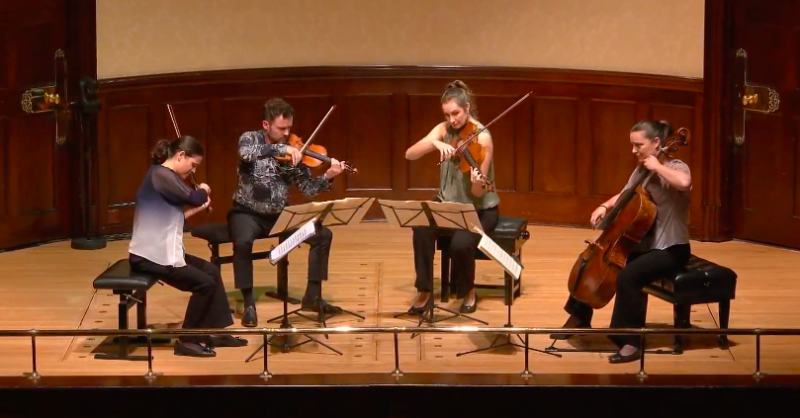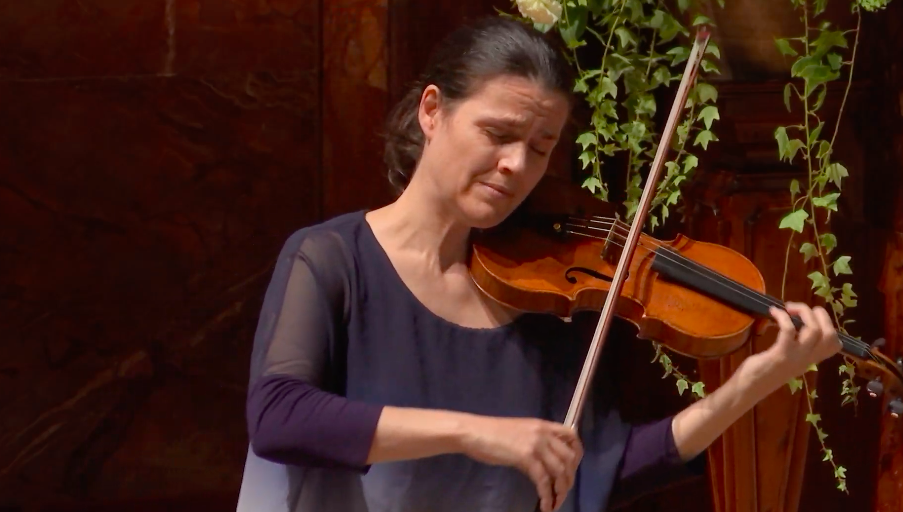Elias Quartet, Wigmore Hall review – sinewy, muscular Beethoven | reviews, news & interviews
Elias Quartet, Wigmore Hall review – sinewy, muscular Beethoven
Elias Quartet, Wigmore Hall review – sinewy, muscular Beethoven
Brisk and cleanly articulated playing, but never lacking expression

You could imagine that normality had returned watching the live webcasts from the Wigmore Hall. The Hall has bucked the trend, and managed to present a full autumn season, to a carefully separated but still substantial audience. Yesterday evening’s concert was to be given by Quatuor Ébène, but they pulled out at the last minute—problems with travelling from France perhaps the reason.
The Elias Quartet ran a year-long Beethoven project about a decade ago, which resulted in an informative website, and a string quartet cycle at the Wigmore Hall, which was released the house label. In other words, they are a known quantity when it comes to Beethoven. Their long association with this music is a clear benefit, and while the two quartets in this recital, op. 127 and op. 59, no. 2, only occasionally showed sparks of interpretive genius, their approach to this music is always personal and distinctive.
The Elias has a sinewy, muscular tone, with keen focus of line and well-balanced ensemble. Their sound sometimes lacks warmth, something the Wigmore acoustic can usually compensate, through not under the close miking of this webcast. The violin tone of leader Sara Bitlloch (pictured below) clearly defines the sound, her playing direct and clearly articulated. But she does not dominate, and the textures often seem built from the bottom up, with Marie Bitlloch on cello (they are sisters) grounding the sound with her prominent and dark bass voice.  Op 127 is the only one of Beethoven’s late quartets to be in a traditional four-movement form, and initially, the Elias players seemed at pains to emphasise the music’s 18th-century roots. The textures of the opening were muscular but expressive, and through the first movement, and the first movement was propulsive throughout. The second movement is a puzzle, a set of variations that sometimes fit together smoothly, but at other times sit in angular juxtaposition. Here, the players focussed more on the mood of each variation and let Beethoven’s awkward transitions stand. The violin melody at the opening set the tone, played expressively but with minimal rubato. The coda returns to this mood, but now with the four players passing the ideas around, a gentle and sensitive interplay. The Scherzo was a bit civilised, with Beethoven’s sporadic outbursts lacking weight. But the finale was more impressive. Beethoven seems to be in two minds here. He opens with a huge chordal gesture, but immediately recedes into less decisive textures. The Elias players brought out this dichotomy with huge dynamic swells, and an impressively guttural sound in the tuttis, supported again by that rich cello tone.
Op 127 is the only one of Beethoven’s late quartets to be in a traditional four-movement form, and initially, the Elias players seemed at pains to emphasise the music’s 18th-century roots. The textures of the opening were muscular but expressive, and through the first movement, and the first movement was propulsive throughout. The second movement is a puzzle, a set of variations that sometimes fit together smoothly, but at other times sit in angular juxtaposition. Here, the players focussed more on the mood of each variation and let Beethoven’s awkward transitions stand. The violin melody at the opening set the tone, played expressively but with minimal rubato. The coda returns to this mood, but now with the four players passing the ideas around, a gentle and sensitive interplay. The Scherzo was a bit civilised, with Beethoven’s sporadic outbursts lacking weight. But the finale was more impressive. Beethoven seems to be in two minds here. He opens with a huge chordal gesture, but immediately recedes into less decisive textures. The Elias players brought out this dichotomy with huge dynamic swells, and an impressively guttural sound in the tuttis, supported again by that rich cello tone.
The Op 59 No. 2 Quartet, the second of the Razumovskys, is middle period Beethoven, and is well suited to the Elias approach of emphasising the Classical elements without underplaying the Romantic passion. The first movement had a valuable sense of urgency, a mood that the ensemble was able to maintain, even across their generous pauses. Although the work is in a minor key, there are many passages of bright, ecstatic textures. These came off well, although the ensemble’s tonal control came unsteady at the loudest dynamics. The slow movement was more stately than sentimental, though the beautifully shaped phrases brought plenty of expression. The scherzo opened with delicate interplay but descended into (controlled) chaos for the Russian theme in the Trio. But the ensemble was never in danger, grounded as ever by the agile but rich tone of the cello. The players gave an outsized rendition of the finale too, achieving the Presto pace, but without reducing their generous bowing or rich tone. The result was chunky and angular, but none the worse for it, with little sense of veneration for Beethoven, but rather a feeling that the players were living one of his few moments of joy.
- The Elias Quartet give a second concert of Beethoven quartets at the Wigmore Hall today, 7 October 2020
- Watch this recital for the next month on the Wigmore Hall website
- More classical reviews on theartsdesk
rating
Explore topics
Share this article
The future of Arts Journalism
You can stop theartsdesk.com closing!
We urgently need financing to survive. Our fundraising drive has thus far raised £49,000 but we need to reach £100,000 or we will be forced to close. Please contribute here: https://gofund.me/c3f6033d
And if you can forward this information to anyone who might assist, we’d be grateful.

Subscribe to theartsdesk.com
Thank you for continuing to read our work on theartsdesk.com. For unlimited access to every article in its entirety, including our archive of more than 15,000 pieces, we're asking for £5 per month or £40 per year. We feel it's a very good deal, and hope you do too.
To take a subscription now simply click here.
And if you're looking for that extra gift for a friend or family member, why not treat them to a theartsdesk.com gift subscription?
more Classical music
 BBC Proms: Liu, Philharmonia, Rouvali review - fine-tuned Tchaikovsky epic
Sounds perfectly finessed in a colourful cornucopia
BBC Proms: Liu, Philharmonia, Rouvali review - fine-tuned Tchaikovsky epic
Sounds perfectly finessed in a colourful cornucopia
 BBC Proms: Suor Angelica, LSO, Pappano review - earthly passion, heavenly grief
A Sister to remember blesses Puccini's convent tragedy
BBC Proms: Suor Angelica, LSO, Pappano review - earthly passion, heavenly grief
A Sister to remember blesses Puccini's convent tragedy
 BBC Proms: A Mass of Life, BBCSO, Elder review - a subtle guide to Delius's Nietzschean masterpiece
Mark Elder held back from blasting the audience with a wall of sound
BBC Proms: A Mass of Life, BBCSO, Elder review - a subtle guide to Delius's Nietzschean masterpiece
Mark Elder held back from blasting the audience with a wall of sound
 BBC Proms: Le Concert Spirituel, Niquet review - super-sized polyphonic rarities
Monumental works don't quite make for monumental sounds in the Royal Albert Hall
BBC Proms: Le Concert Spirituel, Niquet review - super-sized polyphonic rarities
Monumental works don't quite make for monumental sounds in the Royal Albert Hall
 Frang, Romaniw, Liverman, LSO, Pappano, Edinburgh International Festival 2025 review - sunlight, salt spray, Sea Symphony
Full force of the midday sea in the Usher Hall, thanks to the best captain at the helm
Frang, Romaniw, Liverman, LSO, Pappano, Edinburgh International Festival 2025 review - sunlight, salt spray, Sea Symphony
Full force of the midday sea in the Usher Hall, thanks to the best captain at the helm
 Elschenbroich, Grynyuk / Fibonacci Quartet, Edinburgh International Festival 2025 review - mahogany Brahms and explosive Janáček
String partnerships demonstrate brilliant listening as well as first rate playing
Elschenbroich, Grynyuk / Fibonacci Quartet, Edinburgh International Festival 2025 review - mahogany Brahms and explosive Janáček
String partnerships demonstrate brilliant listening as well as first rate playing
 BBC Proms: Akhmetshina, LPO, Gardner review - liquid luxuries
First-class service on an ocean-going programme
BBC Proms: Akhmetshina, LPO, Gardner review - liquid luxuries
First-class service on an ocean-going programme
 Budapest Festival Orchestra, Iván Fischer, Edinburgh International Festival 2025 review - mania and menuets
The Hungarians bring dance music to Edinburgh, but Fischer’s pastiche falls flat
Budapest Festival Orchestra, Iván Fischer, Edinburgh International Festival 2025 review - mania and menuets
The Hungarians bring dance music to Edinburgh, but Fischer’s pastiche falls flat
 Classical CDs: Hamlet, harps and haiku
Epic romantic symphonies, unaccompanied choral music and a bold string quartet's response to rising sea levels
Classical CDs: Hamlet, harps and haiku
Epic romantic symphonies, unaccompanied choral music and a bold string quartet's response to rising sea levels
 Kolesnikov, Tsoy / Liu, NCPA Orchestra, Chung, Edinburgh International Festival 2025 review - transfigured playing and heavenly desire
Three star pianists work wonders, and an orchestra dazzles, at least on the surface
Kolesnikov, Tsoy / Liu, NCPA Orchestra, Chung, Edinburgh International Festival 2025 review - transfigured playing and heavenly desire
Three star pianists work wonders, and an orchestra dazzles, at least on the surface
 BBC Proms: Láng, Cser, Budapest Festival Orchestra, Iván Fischer review - idiomatic inflections
Bartók’s heart of darkness follows Beethoven’s dancing light
BBC Proms: Láng, Cser, Budapest Festival Orchestra, Iván Fischer review - idiomatic inflections
Bartók’s heart of darkness follows Beethoven’s dancing light

Add comment